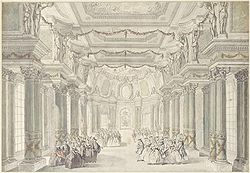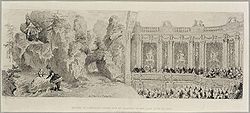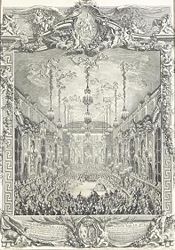- L'Opéra of the Palace of Versailles
-
Opéra of the Palace of Versailles 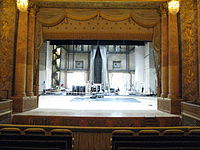
Information about the Opéra royal de Versailles Architect Ange-Jacques GABRIEL (1698-1782) Decorator Augustin PAJOU (1730-1809) Construction dates 1763-1770 Date of inauguration 16 May 1770 Inaugural occasion Marriage of the dauphin (future Louis XVI) with archduchess Marie-Antoinette of Austria Seating, as a theater 712 Accommodation as salle de spectacle 1,200 Construction material Wood Central ceiling painting “Apollo preparing the crowns for illustrious Men of the Arts” by Louis Jean-Jacques Durameau (1733-1796) The Opéra Royal de Versailles (Royal Opera of Versailles) is the main theatre and opera house of the Palace of Versailles. Designed by Ange-Jacques Gabriel, with interior decoration by Augustin Pajou, the Opéra was constructed entirely of wood and painted to resemble marble in a technique known as faux marble.
The house is located at the northern extremity of the aile des nobles. General public access to the theater is gained though the two-story vestibule. Some parts of the Opéra, such as the loge du roi and boudoir du roi represent some of the earliest expressions of what would become known as the style Louis XVI [1].
Lully’s Persée — written in 1682, the year Louis XIV moved into the palace — inaugurated the Opéra on 16 May 1770 in celebration of the marriage of the dauphin — the future Louis XVI — to Marie-Antoinette [2].
The Opéra Royal can serve either as a theater for opera, stage plays, or orchestral events, when it can accommodate an audience of 712, or as a salle des festins, when the floor of the orchestra level of the auditorium can be raised to the level of the stage. On these occasions, the Opéra can accommodate 1,200.
Contents
The French Enlightenment
During the French Enlightenment, the theatre became a place where political and social ideas were considered myths and superstitions were tested. As more Enlightenment thinkers began to question the tenets of religion, many eighteenth-century citizens began to replace the pulpit with the stage, and looked to the theatre for their moral instruction as well as entertainment. [3] The nobility had a lot to do with the uprising of theatre during this time. Louis XIV, who is known as the "Sun King" for playing the allegorical character of the sun in "The Ballet of the Night" in 1653 [4], moved his royal court from the capital, Paris, to Versailles, aspiring to get more control of the government. The Opera, which was built for Louis XV, however, was not built until later. His mistress, Marie de Pompadour, patronized artists, actors, and musicians while bankrupting France. Meanwhile, the aristocracy and church paid no taxes, and the bourgeoisie picked up the tab for the monarchy's tastes and fun [5]. Yet, it was not until after the death of Louis' mistress that the construction of the Opera began [6].
Temporary theatres 1664 to 1674
During the early years of his reign of Louis XIV, theatres were often temporary structures, built for a particular event and destroyed after their use. The first such theater was constructed for the fête of the Plaisirs de l’Île enchantée, which was held in 1664. In the area west of what is now the Bassin d’Apollon, a temporary theater was constructed in which Molière’s Princesse d’Élide débuted on 8 May. During this fête an additional theatre was erected inside the chateau for the presentation of three other plays by Molière: Les Fâcheux, Le Mariage Forcé, and Tartuffe, which premiered in an incomplete, albeit contentious, form. None of these theatres survived this fête [7].
The Grand Divertissement royal of 1668, which celebrated the end of the War of Devolution, witnessed the construction of a luxurious temporary theater built in the gardens on the site of the future Bassin de Bacchus. Constructed of papier-mâché, which was either gilded or painted to resemble marble and lapis lazuli, the theater seated 1,200 spectators who attended the debut of Molière’s George Dandin on 18 July, 1668. As with the Plaisirs de l’Île enchantée, this theater was destroyed shortly after the end of the fête [8].
The third fête or, more accurately, a series of six fêtes - Les Divertissments de Versailles - were held in July and August 1674 to celebrate the second conquest of Franche-Comté. The fête featured a number of theatrical productions that were staged throughout the grounds in temporary theaters. On 4 July, Lully’s Alceste was performed for the court in the Cour de Marbre; on 11 July, Quinault’s L'Églogue de Versailles was staged near the Trianon de Porcelaine; eight days later, the Grotte de Thétys served as the setting for Molière’s le Malade Imaginaire; and Racine’s Iphigénie debuted on 18 August in a theater constructed in the Orangerie [9].
Creation of permanent theatres
La salle de la Comédie, 1681 to 1769
In spite of the need for a permanent theater at Versailles, it would not be until 1681 that a permanent structure would be built. In that year, the Comptes des Bâtiments du Roi record payments for a theater that was constructed on the ground floor of the chateau between the corps de logis and the Aile de Midi. The interior of the theater – known as the salle de la Comédie – contained a semicircle of row seating with loges set into the bays of the lateral walls. On the south wall of the theater, abutting the wall of the Escalier des Princes, was the royal tribune, which contained a central room octagonal loge and two smaller loges on either side [10][11]. The salle de la Comédie would function as a de facto permanent theater at Versailles until 1769, when it was destroyed in order to provide direct access to the gardens from the Cour Royale [12].
Small theatre, 1688 to 1703
In 1688, Louis XIV ordered a small theater to be constructed in the north wing of the Grand Trianon. This structure was destroyed in 1703 to accommodate a new apartment for the king.
Because the salle de la Comédie was designed for stage plays, Versailles lacked a theatre in which more elaborate productions could be staged. For larger productions, the Grand Manège (the covered riding arena) in the Grand Écurie was converted for more elaborate entertainments, but the space had limitations. In 1685, Louis XIV approved plans for the construction of a larger permanent theater that could the more elaborate productions, such as pièces à machines[13].
The pièces à machines were theatrical presentations using ballet, opera, and special staging effects that required a theatre that could accommodate the complicated machinery used in the production of these plays. The Salle des Machines at the Tuileries Palace in Paris, designed by Carlo Vigarani, was the closest to Versailles. However, with Louis XIV’s dislike for Paris – due in large part to his flight from the Tuileries in 1651 – and his increasing wish to keep his court at Versailles, the king approved the construction of a larger theater in 1685. With a plan more grandiose than the theatre of the Tuileries, the construction of this new theatre was much lauded by contemporary descriptions of Versailles [14].
Construction was planned for the northern end of the Aile des Nobles, and was well underway when the War of the League of Augsburg, which began in 1688, permanently halted construction. It would not be until the reign of Louis XV that construction on this site would resume [13].
Return to temporary theatres and conversions, 1729 to 1770
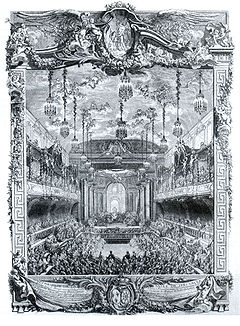 Premiere of Rameau's La princesse de Navarre on 23 February 1745 in the Grande Écurie, engraving by Charles-Nicolas Cochin.
Premiere of Rameau's La princesse de Navarre on 23 February 1745 in the Grande Écurie, engraving by Charles-Nicolas Cochin.
With the return of the court to Versailles in 1722, spaces used by Louis XIV were once again pressed into service for the needs of the court. In 1729, as part of the festivities in celebration of the birth of the dauphin, a temporary theatre was constructed in the Cour de Marbre. The salle de la Comédie and the Manège of the Grand Écurie continued to be used as they had during the reign of Louis XIV.
However, owing to Louis XV proclivity for more a more intimate theater, a number of temporary theaters known as the théâtres des cabinets were created. These theaters were most often constructed in one of the rooms of the petit appartement du roi, with the petite galerie being the most frequently used starting from 1746. In 1748, the Escalier des ambassadeurs was converted into a theatre, in which the Marquise de Pompadour staged and acted in a number of plays. Two years later, the theatre was dismantled when the Escalier des ambassadeurs was destroyed for the construction of the appartement de Madame Adélaïde (Verlet, pp. 366-369).
Acutely aware of the need for a larger and more permanent theater, as early as the 1740s Louis XV, seriously considered reviving Louis XIV’s plans for a permanent salle de spectacle to be constructed at the northern end of the Aile de Nobles. However, owing to the Seven Years’ War, construction would not be able to commence for nearly 20 years. When fire destroyed the Grand Écurie and the theatre of the Manège in 1751, and since the salle de la Comédie had become an unfeasible venue due to its size for theatrical productions, Louis XV finally authorized Ange-Jacques Gabriel to design the Opéra in 1763 [15].
Construction of the Opéra, 1765 to 1770
Construction work on the Opéra began in earnest in 1765 and was completed in 1770. Gabriel reverted to an old design by J.H. Mansart and Gaspare Vigarani: the Salle des Ballets, at the far north end of the château, which had been abandoned at the outbreak of the War of the Spanish Succession. The terminal pavilion of the north wing, intended for this, had been carried up to its full height only on the garden side; on the street side it had advanced no further than the foundations [16]. At the time, it represented the finest example in theatre design, having 712 seats, and it was the largest theatre in Europe. Today, it remains one of the few 18th century theaters to have survived to the present day. Gabriel’s design for the Opéra was exceptional for its time since it featured an oval plan. As an economy measure, the floor of the orchestra level can be raised to the level the stage, thus doubling the floor space. The transition from the auditorium to the stage is managed by the introduction of a giant order of engaged Corinthian columns, with a cornice ranging with the whole Ionic entablature. The proscenium is formed by two pairs of columns, coupled in depth, with their entablature. On either side two more pairs, more widely spaced, enclosed with three tiers of boxes [17]. Breaking with traditional Italian-style theatres which stacked tiered boxes like chicken coops, two balconies ring the house, topped by an ample colonnade that seems to extend into infinity thanks to a play of mirrors [18]. It was planned that the Opéra should serve not only as a theatre, but as ballroom or banqueting hall as well [19]. The theatre burned ten thousand candles in a single setting, therefore making it very expensive to rent the space out.[citation needed]
It opened May 16, 1770, with Lully's Persée [20].
On 1 October 1789, the gardes du corps du roi held a banquet to welcome the Flanders Regiment, which had just arrived to strengthen protection for the royal family against the revolutionary rumblings that were being heard in Paris. At this banquet, Louis XVI, Marie-Antoinette, and the dauphin received the pledge of loyalty from these guards. Revolutionary journalist Jean-Paul Marat described the banquet as a counter-revolutionary orgy, with the soldiers ripping off the blue-white-red cockades they had been wearing and replacing them with white ones, the color that symbolized the Bourbon monarchy. In truth, there is no evidence of this act, and actual eyewitnesses and attendees, such as the queen's lady of the bedchamber Madame Campan, record no such destruction of cockades. This was the last event held in the Opéra during the Ancien Régime [21].
Built entirely of wood, which is painted in faux marble to represent stone, the Opéra has excellent acoustics and represents one of the finest examples of neo-classical decoration. The theme of the decoration is related to Apollo and the Olympian deities. The decoration of the Opéra was directed by Augustin Pajou, who executed the bas-reliefs panels that decorate the front of the loges. The ceiling features a canvas by Louis Jean-Jacques Durameau in which Apollo and the Muses are depicted [22].
In spite of the excellent acoustics and the opulent setting, the Opéra was not often used during the reign of Louis XVI, largely on grounds of cost. However, for those occasions when the Opéra was used, they became events of the day. Some of the more memorable uses of the Opéra during the reign of Louis XVI included:
- 5 May 1777: Revival of Jean-Philippe Rameau’s, Castor et Pollux for the visit of the Emperor Joseph II, Marie-Antoinette’s brother.
- 23 May 1782: Revival of la Reine de Golconde by Michel-Jean Sedaine;
- 29 May 1782: Revival of Christoph Willibald Glück’s opera, Iphigénie en Aulide and the revival of Maximilien Gardel’s ballet Ninette à la Cour;
- 8 June 1782: Dress ball held in honor of the visit of the comte and comtess du Nord, the Grand Duke Paul and Grand Duchess of Marie Feodorovna of Russia who were traveling incognito [23]. [24]
- 14 June 1784: Revival of Glück’s Armide for the visit of Gustav III of Sweden [25].
The Opéra after the Revolution
When the royal family left Versailles in October 1789, the château and the Opéra were closed. While the château did see some activity under Napoléon I (redecoration of the parts of the queen’s apartment for the empress Marie-Louise) and Louis XVIII, the Opéra did not reopen again until 1837, when Louis-Philippe redecorated the theater and presented Molière’s Le Misanthrope. During the state visit of Queen Victoria and Prince Albert the Opéra Royal was converted into a banquet room for a gala dinner on 25 August 1855 [26]. This was to be one of the most elaborate events staged at Versailles during the Second Empire.
In 1872, during the Commune de Paris, the Opéra was converted by Edmond de Joly for use by the Assemblée nationale, who used the Opéra until 1876; between 1876 and 1879, the Sénat convened here.[27]
The Opéra Royal since 1950
1952-1957 witnessed major restoration of the Opéra – generally considered one of the finest restoration projects undertaken at Versailles – when it was restored under the direction of André Japy to its 1770 state (Verlet, p. 384). The Opéra officially reopened on 9 April 1957 in the presence of Queen Elizabeth II of the United Kingdom, with a presentation of Act II of Rameau’s Les Indes Galantes. Since its restoration, the Opéra has been used for state functions as well as a variety of operatic and musical events (Langlois, 1958).
Today, with its superb acoustics and magnificent décor, the Opéra represents one of the finest 18th century opera houses in Europe. The importance of the Opéra Royal is directly linked to the history of the many theatres at Versailles and the history of theatrical stagings in 17th and 18th century France.
Gallery of images
Termporary theaters during the reign of Louis XIV 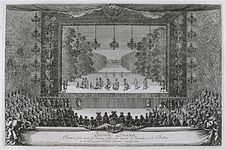
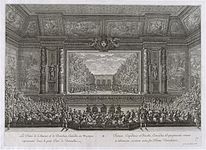
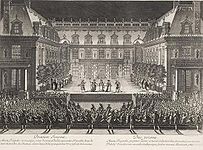

Les Plaisirs de l'Ile Enchantée, termporary theater built for the production of Molière’s la Princess d’Élide (8 May 1664). Silvestre Israël Silvestre, 1621-1691. Grand Divertissement royal, temporary theater built for the production of Molière’s Georges Dandin (15 July 1668) Jean Le Pautre, 1618-1682. Les Divertissments de Versailles, the Cour de Marbre serving as a theater for the production of Quinault’s and Lully’s Alceste (4 July 1674). Les Divertissments de Versailles, temporary theater built before the Grotte de Thétys for the revival of Molière’s le Malade imaginaire. (18 July 1674). Jean Le Pautre, 1618-1682. The Opéra royal during the 18th and 19th centuries 
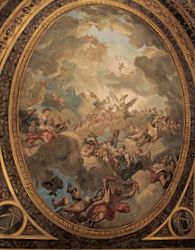

“Inauguration of the Opéra, 16 May 1770.”
Jean-Michel Moreau (1741-1814).
Ceiling of the Opéra royal de Versailles. “Apollo preparing the crowns for illustrious Men of the Arts” ca. 1770.
Louis Jean-Jacques Durameau (1733-1796).
Auditorium of the Opéra de Versailles during the celebrations of the wedding of the dauphin and Marie Antoinette in 1770.
Jean-Michel Moreau (1741–1814).
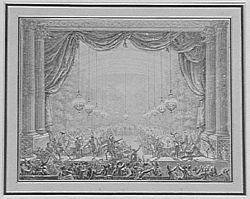
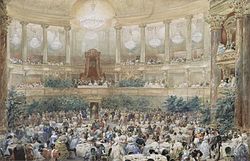
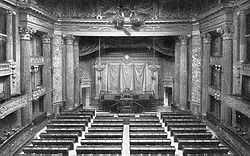
“Banquet of the gardes du corps given in the Opéra de Versailles, 1 October 1789.”
Jean-Louis Prieur (1759-1795).
Banquet offered by Napoléon III to Queen Victoria and Prince Albert in the Opéra de Versailles, 25 August 1855.
Eugène Lami (1800-1890)
The Opéra de Versailles converted for the use of the Sénat of the Third Republic, ca. 1876. References
- Notes
- ^ Marie, 1984
- ^ Verlet, p. 382
- ^ "UCB Libraries | Special Collections | The Enlightenment." UCB Libraries | Home Page. N.p., n.d. Web. 28 Feb. 2011. http://ucblibraries.colorado.edu/specialcollections/exhibits/past/enlightenment/index.htm.
- ^ Gallo, Max. "Louis XIV : The Sun King - French fiction de Max Gallo." Editions XO : Lire pour le plaisir. N.p., n.d. Web. 28 Feb. 2011. http://www.xoeditions.com/Louis-XIV,204
- ^ Kuritz, Paul. "The Making of Theatre History." Google Books. Web. 27 Feb. 2011. http://books.google.com/books?id=cS6JV4Z27DoC&pg=PA208&lpg=PA208&dq=louisXVtheatre&source=bl&ots=f2ww_i4iC3&sig=xR8BD7KisucxcNHzBaU_1jAE_bs&hl=en&ei=zB9rTc2yA4OClAf5xKH_AQ&sa=X&oi=book_result&ct=result&resnum=9&ved=0CEUQ6AEwCDgK#v=onepage&q=louis XV theatre&f=false
- ^ Braham, Allan. The architecture of the French Enlightenment . Berkeley: University of California Press, 1980. Print.
- ^ Verlet, pp. 54-59
- ^ Verlet, pp. 70-72
- ^ Verlet, pp. 117-119
- ^ Verlet, p. 281
- ^ Coeyman, "Theaters for Opera and Ballet during the reigns of Louis XIV and Louis XV", pp. 22-37
- ^ Verlet, pp. 361-362
- ^ a b Verlet, p. 283
- ^ Félibien, p. 208
- ^ Verlet, p. 377
- ^ Kalnein, Wend von. Architecture in France in the eighteenth century . New Haven: Yale University Press, 1995. Print.
- ^ Ward, M.A., W. H.. The Architecture of the Renaissance in France. Second ed. New York: Hacker Art Books, 1976. Print.
- ^ "France - Paris - Chateau de Versailles." White Mouse Burrow. White Mouse, RU, n.d. Web. 23 Jan. 2011. http://whitemouse.ru/photo/paris/versailles_chateau.wmb
- ^ Verlet, p. 378
- ^ Praefcke, Andreas. "Carthalia - Versailles: Theatre Gabriel." Andreas Praefcke - Homepage. N.p., n.d. Web. 23 Jan. 2011. http://www.andreas-praefcke.de/carthalia/france/f_versailles_gabriel.htm
- ^ Verlet, p. 559
- ^ Verlet, pp. 379-380
- ^ Verlet, p. 555
- ^ For the festivities provided during the visit of Grand Duke Paul and Grand Duchess Marie, the Menus-Plaisirs recorded expenses at more than 200,000 livres for the second quarter of 1782.
- ^ Verlet, pp. 554-555
- ^ Verlet, p. 668
- ^ Today, when the Assemblée nationale and the Sénat meet in joint session, they do so at Versailles, not in Paris. On these occasions, Versailles becomes the de-facto capital of France. To accommodate the members of the Sénat, the north wing of the château, in the part that faces the city of Versailles, over 300 apartments have been arranged for the private use by members of the upper house of France’s parliament.
- Sources
- Coeyman, Barbara (May 1993). "Sites of Indoor Musical-Theatrical Productions at Versailles". Eighteenth Century Life vol. 17, n.s., 2: 55–67
- Coeyman, Barbara (February 1990). "Theaters for Opera and Ballet during the reigns of Louis XIV and Louis XV". Early Music vol. 18, no. 1: 22–37
- Félibien, Jean-François (1703). Description sommaire de Versailles ancienne et nouvelle. Paris: A. Chrétien.
- Langlois, Rose-Marie (1958). L’Opéra de Versailles. Paris.
- Marie, Alfred and Jeanne (1984). Versailles au temps de Louis XV. Paris: Imprimerie Nationale.
- Nolhac, Pierre de (1911-1918). Histoire de Versailles. 3 v. Paris: André Marty.
- Piganiol de la Force, Jean-Aymar (1701). Nouvelle description des châteaux et parcs de Versailles et Marly. Paris: Chez Florentin de la lune.
- Verlet, Pierre (1985). Le château de Versailles. Paris: Librairie Arthème Fayard.
Coordinates: 48°48′21.5″N 2°7′22″E / 48.805972°N 2.12278°E
Categories:- Palace of Versailles
- 1770 architecture
Wikimedia Foundation. 2010.

